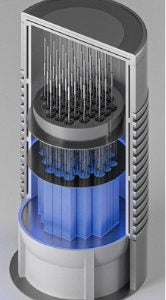Fusion breakthroughs are amplifying the drive to see nuclear power in a different light. It’s a key development but it is also an important part of a re-energised industry.
The fusion breakthrough accomplished late last year by the US National Ignition Facility (NIF) at Lawrence Livermore National Laboratory is a remarkable step forward on the road to commercial fusion power.
As the first ever controlled fusion reaction to produce more energy than it took to initiate, the laser-based inertial fusion project has achieved a major milestone – nearly 200 lasers delivered 2.05 megajoules (MJ) of energy to a tritium/deuterium target. The result was an output of 3.15 MJ of fusion energy.
Without taking anything away from the brilliance of the scientists and engineers behind this achievement, perhaps more remarkable is that this success is just one of a host of recent fusion developments. Collectively, they serve as clear evidence not only of re-energised interest in fusion power, but obvious pathways to commercialisation.
Novatron Fusion Group, for example, has secured funding for its fusion concept that will help build a new test facility to validate their approach to plasma confinement. Their aim is to have a commercial design that enables net-power to be supplied to the grid before 2040.
In the UK, meanwhile, Tokamak Energy’s device, the ST40, achieved a plasma temperature of 100 million °C after recently returning to operations following an upgrade. The highest temperature ever achieved in a privately-funded spherical Tokamak, the company says it plans to demonstrate grid-ready power by the early 2030s.
Longview Fusion Energy Systems, has already announced plans to commercialise the NIF development with the stated ambition to build the world’s first laser fusion power plant with modern, more efficient lasers and better fuel designs.
There are many similar examples (see page 36) in which companies are looking to establish commercially-viable and proven fusion power plant designs during the 2030s and 2040s.
The fact that many of these endeavours are privately financed is also suggestive. Whereas fusion has typically been dismissed as a nice concept but one that will take 50 years to realise, now it seems there are some big players lining up and ready to stake some serious cash. They just don’t do that on a whim.
It is of course important to recognise that fusion is no global panacea yet. Even if commercial fusion is demonstrated within the coming decade, it will take many more years before it can contribute more than a few percent to our steadily growing global energy demand. Nonetheless, by demonstrating that fusion is now far more than an attractive idea, the NIF result is among a range of developments that has helped establish a sea change of opinion. Alongside breakthroughs in small modular and advanced reactors, growing – if belated – recognition of the looming climate change catastrophe, and the energy crisis precipitated by conflict in Ukraine, the emerging success of fusion technology is another big tick in the positives box for nuclear power. And this may yield important additional benefits to the nuclear industry. At the birth of the nuclear age, the power of the atom was seen as futuristic, wholesome and beneficial. Nuclear power was clean, modern and apparently destined to become too cheap to even meter. For all its potential, decades of subsequent decline and some notable disasters saw nuclear all but relegated to a ‘has-been’ industry of managed decay in the minds of many. That’s no longer the case. As we begin a new year the industry can take heart in the knowledge that nuclear is once again seen as futuristic and full of opportunity to make real and positive changes in the lives of billions of people. Nuclear power is already clean, secure and cost effective but that change in perception is hugely important if the sector is to attract the brightest and best of our youth. For it is the brilliant engineers of tomorrow who will lead this industry forward and who will ultimately deliver on the long-held promise of nuclear power. From all at NEI, we wish you a happy, healthy and successful 2023.
By David Appleyard, Editor, Nuclear Engineering International






